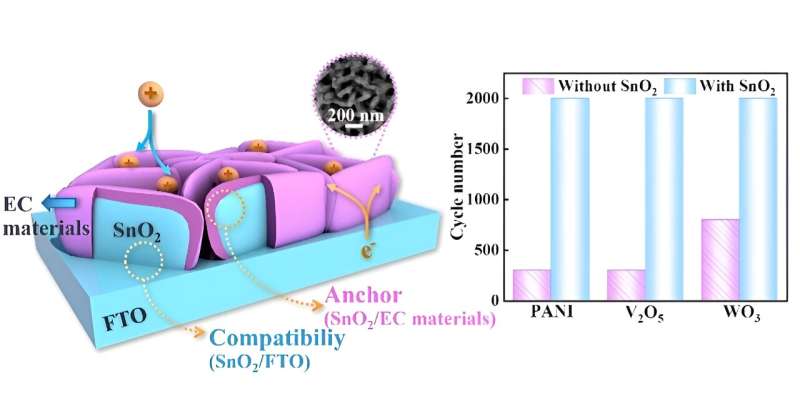
Vivid displays, enriched color variations and boosted stability are something everyone can look forward to encountering as advances are made in the electrochromic device (ECD) field
Electrochromic devices (ECDs) are useful in controlling optical properties such as reflection and absorption and are particularly pertinent when it comes to use in smart windows, rearview mirrors and adaptive camouflage. Unfortunately, the widely used electrochromic materials show a lackluster display with minimal color changes and poor cycling stability, often only transforming between transparency and a single color with sluggish switching speeds.
This study demonstrates the use of a more compatible component in the form of a highly porous tin oxide (SnO2) nanosheet scaffold, which provides better cycling, more color variations and a seamless performance than what the current technology has to offer.
Researchers published their work in Nano Research.
“We have demonstrated a general strategy to boost the cycling stability and optical modulation of typical electrochromic materials (e.g., PANI, V2O5, WO3) by introducing a nanostructured SnO2 nanosheet scaffold between active electrochromic materials and the conducting substrates,” said Guofa Cai, researcher and author of the study.
The typical electrochromic materials used now are polyalanine (PANI) and vanadium pentoxide (V2O5) but these materials aren’t ideal due to their poor adhesion to the substrate they are mounted upon, among other issues leading to poor cycling stability and limited color range.
Incompatible layers in the “sandwich” style composition of the five functional layers comprising an ECD are the starting point for creating a better product more capable of vivid coloration in the displays and long-lasting stability when cycling between coloring or bleaching.
“The porous SnO2 scaffold enlarges the electrochemical active area and facilitates the diffusion of ions, thereby enhancing the electrochromic properties of the composite films,” said Cai.
By introducing a nanostructured scaffold between the substrate layer and active electrochromic components, a better heterostructure is achieved. This is thanks to the increased porosity of the SnO2 nanosheet scaffold which allows for better transportation of ions between the layers, as well as the improved adhesion ability. These changes, which may seem small, have quite an effect on the overall performances of ECDs when comparing the same electrochromic materials with and without the SnO2 nanosheet scaffold.
The SnO2 scaffold improved color changes in the composite electrode V2O5 and the optical modulation of WO3 (tungsten trioxide) by 16%. Moreover, the optical cycling stability also showed improvement: both WO3 and V2O5 lasted over 2000 cycles with SnO2, and without only lasted around 300 and 1300 cycles, respectively.
This is a significant difference, especially for technologies that might cycle from colors and opacity multiple times per day or even per hour, like in windows or electronic displays.
The use of typical metal oxides or conducting polymers as active electrochromic materials, along with the tin oxide nanosheet scaffold, are what allow for such rich color variations that haven’t been seen before this research. Going forward, a wider array of exciting and varying colors may be in store for ECDs.
This can improve the appearance and performance of emerging electrochromic devices such as e-paper, smart windows, and electronic displays, and might reduce waste later down the line when ECDs using more “traditional” compositions fail to cycle appropriately and have to be replaced.
The future of electrochromic devices using SnO2 as a scaffold is a bright one, and the study uncovered few, if any, issues. One thing researchers noticed was a longer than desired switching time during the coloration process. This could be worked on to be shortened in later iterations of the process, but is not a major concern, especially when considering the success of the study over the currently available technology.
More information:
Chenchen Bian et al, Complementary multicolor electrochromic devices with excellent stability based on porous tin oxide nanosheet scaffold, Nano Research (2023). DOI: 10.1007/s12274-023-6103-2
Journal information:Nano Research
Provided by
Tsinghua University Press

READ MORE
Novak Djokovic
Serbian tennis star Novak Djokovic is one of the greatest players in the sport’s history, [...]
Unveiling the Ingenious Invention: The Electric Pen
Thomas Edison’s electric pen was a forerunner to today’s electric tattoo machines. Samuel O’Reilly saw [...]
The Bizarre Tale of the Middle East’s First Space Program
Cedar 7 at take-off Courtesy Manoug Manougian After 15 years of ferocious urban combat, you [...]
How the Grail Engine Works
The Grail engine. See more pictures of engines. Courtesy of Grail Engine Technologies What if [...]
To Limit Pollution, The Chinese Are Faced With Giving Up an Ancient Tradition
Fireworks over Beijing during 2013’s Lantern Festival Courtesy of Flickr user Ray K Keeping the [...]
Tiny nanoparticle could have big impact on patients receiving corneal transplants
A single SCT injection of PLGA DSP-NP at POD3 provided short-term reversal of corneal graft [...]
Yoga and Weight Loss: Does yoga burn belly fat?
Yoga can help with weight loss — just not in the way you may think. [...]
A window into the nanoworld: Scientists develop new technique to image fluctuations in materials
The principle of Coherent Correlation Imaging is used to image a random process, such as, [...]